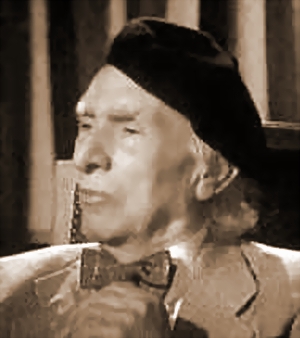John Alton facts for kids
Quick facts for kids
John Alton
|
|
|---|---|

Screen-capture
|
|
| Born |
Johann Jacob Altmann
October 5, 1901 |
| Died | June 2, 1996 (aged 94) |
| Occupation | Cinematographer |
| Spouse(s) |
|
John Alton (born Johann Jacob Altmann on October 5, 1901 – died June 2, 1996) was a famous American cinematographer. A cinematographer is the person in charge of how a movie is filmed. They decide on the camera angles, lighting, and overall look of the film.
John Alton was born in Sopron, which was part of the Kingdom of Hungary at the time. He became well-known for his work on many classic "film noir" movies. These are often dark and mysterious films. He also won an Academy Award for his amazing camera work on the musical movie An American in Paris (1951). He was the first person born in Hungary to win an Oscar for cinematography!
Contents
John Alton's Career in Film
John Alton started his journey in the film world in the 1920s. He moved to the United States for college. One day, he was spotted by someone looking for extras at a movie studio in New York. This was his first step into the industry.
He began working in a film lab in Los Angeles. Within four years, he became a cameraman. This means he operated the camera during filming.
Working Around the World
Alton traveled to France with director Ernst Lubitsch. They filmed backgrounds for a movie called The Student Prince in Old Heidelberg (1927). He ended up staying in France for a year. During this time, he led the camera department for Paramount Pictures's studio there. He even said he discovered the famous French singer and actor Maurice Chevalier!
In 1932, Alton moved to Argentina. He filmed many Spanish-language movies there. He also helped design Argentina's first sound film studio. He planned to stay for only a year but ended up living there for seven years! He even won an award for best photography in Argentina in 1937.
Return to Hollywood
Alton came back to Hollywood in the late 1930s. He worked on about 30 "B-movies" in seven years. B-movies were usually lower-budget films made quickly. He often worked for Republic Pictures and RKO.
Later, he teamed up with director Anthony Mann for the movie T-Men (1947). This made him one of the most popular cinematographers. He was known for his unique camera angles, especially low shots. You can see his special style in film noir movies like He Walked by Night (1948) and The Big Combo (1955).
Color Films and Awards
John Alton also filmed many movies in color. One example is Slightly Scarlet, which was a color film noir. He worked with director Vincente Minnelli at MGM for ten years. Together, they made famous movies like Father of the Bride (1950).
He won an Academy Award for his work on An American in Paris (1951). He shared this award with Alfred Gilks. Alton also worked several times with director Richard Brooks, on films such as Battle Circus (1953).
Alton's last film was Elmer Gantry (1960). He briefly worked on Birdman of Alcatraz (1962) but left the industry shortly after.
Television Work
In 1966, John Alton filmed the very first episode, called the "pilot," for the TV show Mission: Impossible. This show became very popular!
John Alton's Book: Painting with Light
John Alton wrote a book called Painting with Light (1949). It was one of the first books written by a working cinematographer. In his book, Alton shared some new ideas about lighting for movies. For example, he suggested that the brightest object in a scene should be furthest from the camera to create depth. He also believed that studio lighting should always look like natural light.
The book gives detailed information and ideas for lighting different scenes. Even though movie technology has changed a lot, many of his ideas are still useful today for new filmmakers. The book has interesting chapters like "Mystery Lighting" and "Visual Symphony."
Personal Life
After leaving the movie business, John Alton and his first wife, Rozalia, traveled the world. They stayed out of the public eye. They lived in Europe, South America, South Africa, and Asia. They met in Argentina and were married for 55 years until Rozalia passed away. In 1986, he married his second wife, Billie, who also passed away in the early 1990s.
Death
John Alton died on June 2, 1996, in Santa Monica, California. He was 94 years old.
Selected Filmography
- The Student Prince in Old Heidelberg (1927)
- Los tres berretines (1933)
- Amalia (1936)
- Remedy for Riches (1940)
- The Lady and the Monster (1944)
- Atlantic City (1944)
- T-Men (1947)
- He Walked by Night (1948)
- The Amazing Mr. X (1948)
- Raw Deal (1948)
- Mystery Street (1950)
- Father of the Bride (1950)
- An American in Paris (1951)
- Battle Circus (1953)
- The Big Combo (1955)
- Slightly Scarlet (1956)
- The Teahouse of the August Moon (1956)
- The Brothers Karamazov (1958)
- Elmer Gantry (1960)
Awards and Honors
John Alton received several important awards and honors for his work:
Wins
- Academy Awards: He won an Oscar for Best Cinematography (Color) for An American in Paris in 1951. He shared this award with Alfred Gilks.
Nominations
- Laurel Awards: He was nominated for the Golden Laurel for Top Cinematography (Color) for The Brothers Karamazov in 1959.
Other Honors
- Los Angeles Film Critics Association Awards: He received a Career Achievement Award in 1992. This award recognized his entire body of work and contributions to film.
See also

- In Spanish: John Alton para niños

